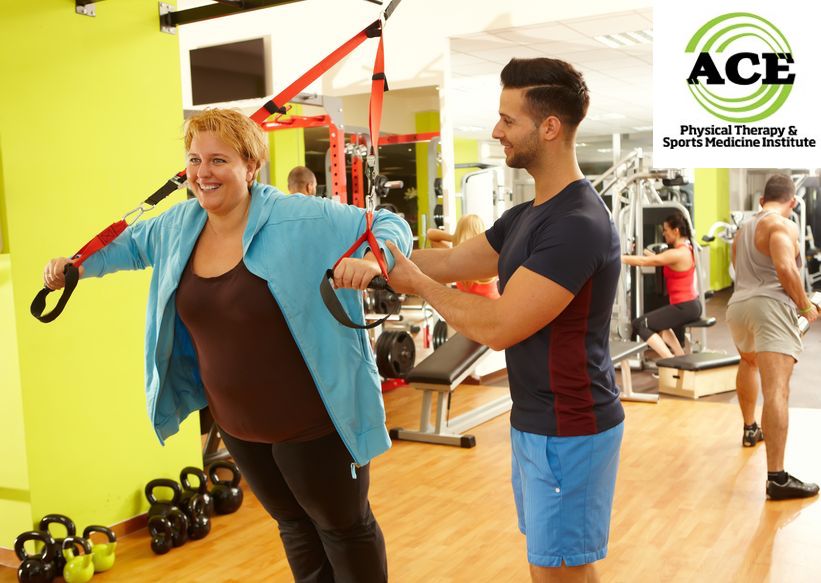FITNESS VS REHABILITATION
 Fitness Vs Rehabilitation
Fitness Vs Rehabilitation
by ACE Physical Therapy and Sports Medicine Institute
Tid Bits of Info.
- More than 600,000 people in the U.S. alone die from heart disease yearly.
- Cardiovascular improvement can be accomplished within 3-4 of a dedicated exercise routine.
- Human movement is dependent upon muscle action. Movement is a synchronized pattern of muscle contractions controlled by the nervous system.
- It will take a minimum of 4 weeks (usually at least 6) to experience a biochemistry change in the muscle that indicates that a strength gain occurred.
- Seek the advice and treatment of a Physical Therapist if you are deconditioned or sustain an injury.
Danny achieved business success as the new V.P. of sales for a local marketing firm. Even as his career began to soar, his physical fitness diminished. He had been in really good physical shape when he was in college and he exercised regularly, but after he graduated and pursued a career he had could not find the time to exercise on a regular basis. As V.P., he often worked nights and weekends but quit working out.
He gained weight and had a difficult time walking up a flight of stairs without experiencing shortness-of-breath. The final straw that led to a change in his lifestyle occurred when he was on vacation in Europe and had significant difficulty walking around to see the different sights. He was embarrassed that he had to rely on various modes of transportation and was unable to walk around to “sight-see”. He could not walk further than a couple of blocks without experiencing fatigue and leg pain. If you have ever been to a European city, you know that walking is the primary mode of transportation for most residents and many tourists. Many of the sights require extensive walking on stairs and being in poor physical condition can ruin your trip.
Physical fitness involves both physical and mental health. When someone is physically fit they are able to perform daily activities without experiencing pain and fatigue, plus they feel good mentally. Their energy level is higher and their outlook on life and the task at hand is more positive. The primary components of a physical fitness program are strength, endurance, cardiovascular health, and flexibility.
Danny was physically fit when he was in college because he spent time exercising on regular basis. He spent several hours per week maintaining a conditioning program that consisted of 30 – 45 minutes of cardiovascular exercise that raised his heart rate to at least 70% of his maximum (maximum heart rate can be roughly determined by the following formula: 220 – your age). He would lift weights and performed various strengthening exercises that challenged his whole body. He performed 15 repetitions and did 3 sets of each exercise. He made sure that his last 2-3 repetitions were difficult, but he always had good form and no joint pain. He was able to go to the gym 3 times per week and did a similar, whole body circuit type training program when he was there. This type of routine helped to establish sufficient strength and muscular endurance that enabled him to remain relatively pain-free. When he had done his exercise program, he would have spent 15-20 minutes performing a full body stretching routine. He was able to stretch the non-elastic soft tissue as well as the elastic muscle tissue which is the key to remaining flexible.
Being in “good shape” and maintaining the strength, flexibility, and cardiovascular fitness enables someone to avoid many situations that can cause an injury to occur to their body. If Danny had injured himself and not let himself get totally deconditioned, he would have pursued a thorough rehabilitation program at a Physical Therapy center. The rehabilitation program would have addressed many of the same problems but would have centered on the injured body part. The Physical Therapist would evaluate the injury site and then develop a complete rehabilitation protocol that would be geared towards restoring the normal function of the injured body part. The program would begin with treatment that would reduce the symptoms and when appropriate the focus of the rehabilitation program would be progressed to enhance the function of the injured body part. In most instances, the protocols would include exercises, activities and the use of modalities and manual techniques that are designed to improve strength, endurance (muscular and cardiovascular if necessary), neuromuscular efficiency and flexibility. If all of these areas are addressed thoroughly, the functional capability of the injured body part will be restored to pre-injury status.
Danny was deconditioned and needed to pursue a well-designed fitness program that would enhance his muscular strength, endurance, flexibility and cardiovascular health. He allowed himself to become deconditioned and more susceptible to injury due to his prolonged inactivity and sedentary, stressful lifestyle. Danny is not alone and unfortunately, his lifestyle is the “norm” for too many people. Staying active and maintaining a regular exercise routine requires a great deal of dedication and has to become a lifestyle preference, but the benefits can be enormous and life changing!
Read more articles on our main website blog at: ACE-pt.org/blog
Vist our main website at www.ACE-pt.org

